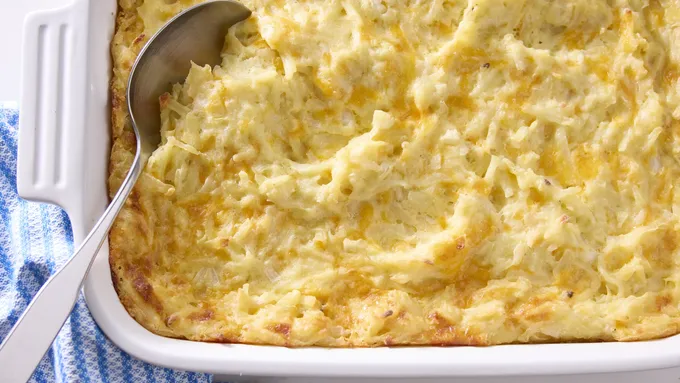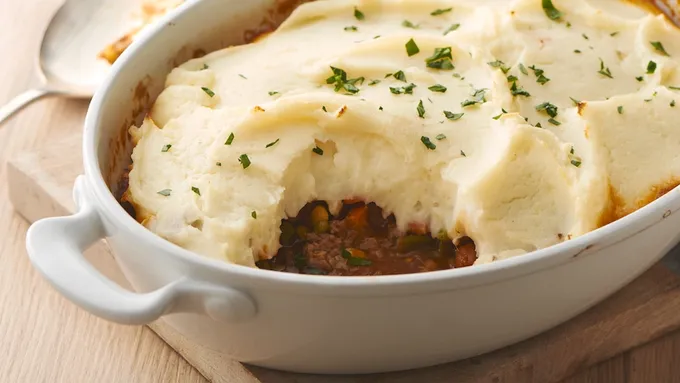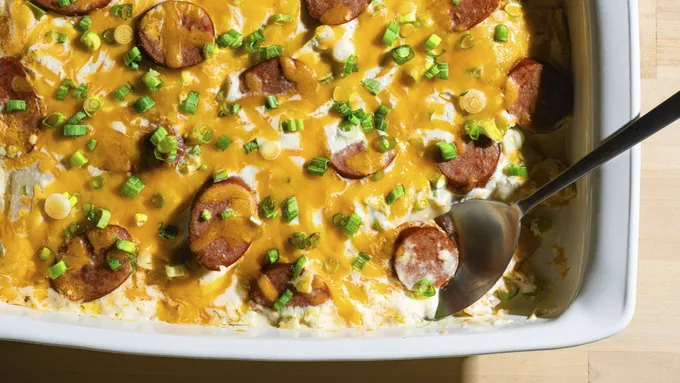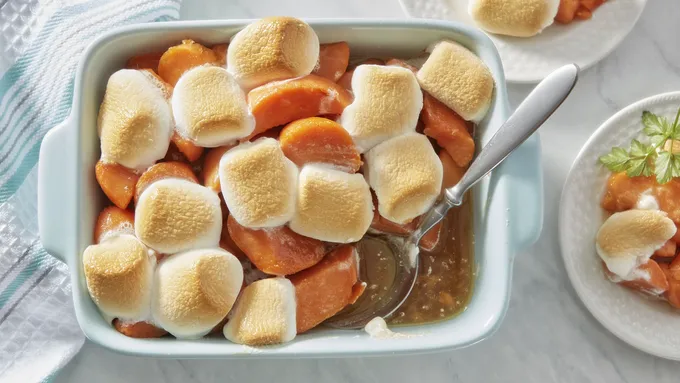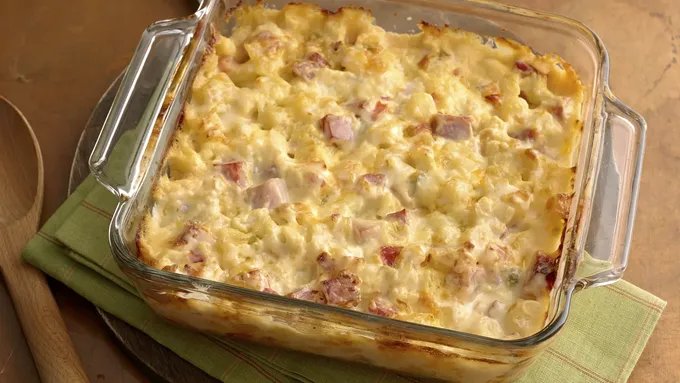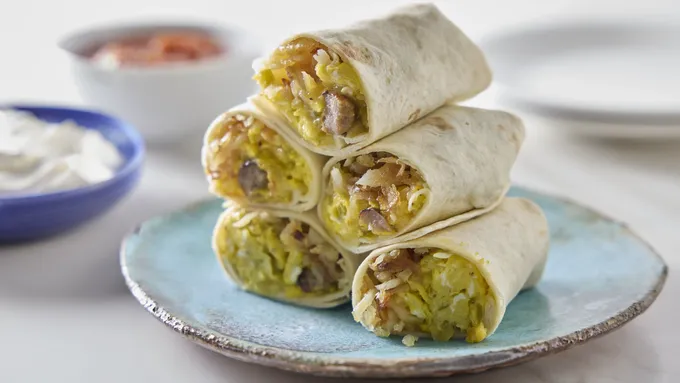Recipe Ingredients
This recipe uses just 5 simple ingredients to make the best mashed potatoes.
Potatoes: We like Russet, Idaho, or yellow potatoes (Yellow Finn or Yukon Gold) for this recipe, because they make the smoothest, fluffiest homemade mashed potatoes.
Milk: The higher the milk fat content, the richer the mashed potato flavor will be. We have tested with everything from skim milk to heavy cream—honestly, they all work. Use what you have on hand or the decadence level you’re going for. We use milk that’s been heated to keep the potatoes piping hot for eating.
Butter: We found that 2 tablespoons is the right amount for that lightly butter-rich flavor, without becoming greasy or heavy tasting. Real butter offers the best flavor and texture over margarine or butter substitutes.
Salt and Pepper: We found that salting the water while cooking the potatoes and adding a little salt while mashing them gives the best overall flavor.
The Best Potatoes for Mashed Potatoes
The key to how to make mashed potatoes that are smooth and creamy is in the potatoes you use. After testing more than 8 types of common potatoes, here’s what we found.
Russet or Idaho: These starchy potatoes readily fall apart when cooked, so they mash the easiest. They also absorb milk and butter well, creating fluffy mashed potatoes that are neither soupy nor paste-like.
Yellow Potatoes—Yellow Finn or Yukon Gold: Good all-purpose potatoes that can also be used in mashed potatoes with great results, giving them more of a creamy, yellow appearance.
Avoid Waxy Potatoes—Fingerling, New, or Red: The waxy, creamy-moist interiors of these potatoes hold their shape when cooked, so they don’t easily mash. It’s hard to get the lumps out of them for creamy mashed potatoes, and they don’t absorb liquids well, so mashed potatoes made with them will be soupier. Save these potatoes for salads or roasting, where you want to retain the shape of the pieces.
Cookware You’ll Need
Vegetable Peeler: Use to quickly remove a thin layer of potato skin.
Large Saucepan: A 3-or 4-quart size works well to hold the potatoes and water without allowing them to boil over. Since the potatoes will be mashed and mixed with the other ingredients right in the pan, larger-size pans make this easier to do. Be sure to pick a burner to cook the potatoes on that is sized for the pan. Too small or too large of a burner will affect the cook time.
Colander: Essential for completely draining off the cooking water from the potatoes.
Potato Masher: Absolutely the right tool for the job. It gets the potatoes mashed quickly and evenly.
Rubber Scraper: After making mashed potatoes for more than 30 years, one of our experts recommends using a rubber scraper to get potato out of the “corner” of the pan, so that all of the potato pieces can be mashed until they are smooth.
How to Make Mashed Potatoes
1. Peel and Cut the Potatoes
Using a vegetable peeler to remove just the skin is quickest and easiest. If you don’t have a peeler, carefully use a paring knife. Then, cut the potatoes into quarters.
2. Cook and Drain the Potatoes
Place potatoes in the pan and cover with enough water to entirely submerge. Heat until boiling over high heat. Then, reduce the temperature, cover the potatoes, and gently boil for 15 minutes over medium-low heat. Using a fork, check a few of the largest pieces to see if they fall apart easily. If not, cook another minute or two until they do. Pour potatoes into the colander, shake it a few times to remove all the water, and return the drained potatoes to the pan.
3. Remove Excess Moisture
This step sets apart great mashed potatoes from average ones: Shake the pan with drained potatoes over low heat for a minute or two to evaporate any water left on the potato pieces. The drier the pieces, the fluffier your mashed potatoes will be.
4. Mash and Add Remaining Ingredients
With the heat off, mash the potatoes until no lumps remain. Do this before adding the other ingredients to retain the fluffiest texture. Then, mash in the butter, remaining salt and pepper. Gradually add the milk, about a tablespoon at a time, adding only enough to make them a creamy consistency and stirring only until it’s just absorbed. Overmixing can cause the potatoes to have a paste-like consistency.
Variations and Serving Suggestions
We’ve heard from our consumers that you like to stir in additional ingredients to change up this recipe.
Substitute Sour Cream: One reviewer said, “Mashed potatoes are my and my husband's very favorite. I use sour cream in place of butter. It makes the potatoes fluffier, and they have that sour cream taste.” Try substituting 1/4 cup sour cream for the butter.
Add Cream Cheese: Stir in 2 ounces of softened cream cheese with the milk.
Include Herbs: Gently stir in a tablespoon or so of chopped fresh parsley, cilantro, or basil leaves before serving.
For a different mashed potato recipe, try one of these tasty options:
Slow-Cooker Mashed Potatoes: Free up your stove when you’re cooking for a crowd.
Garlic Mashed Potatoes: Skip peeling potatoes to make these home-style garlic mashed potatoes in the slow cooker.
Serve this classic mashed potato recipe with just about anything. For a delicious holiday spread, pair with our Best Roast Turkey, or for weeknights, try easy mashed potatoes with Meat Loaf.
Storing and Reheating
Leftover creamy mashed potatoes can give you a jump-start on a quick meal. Remember to store leftover mashed potatoes within 2 hours of serving them to prevent bacterial contamination from causing food borne illness.
Refrigerator
Place leftover mashed potatoes in resealable food storage containers. Store in the refrigerator up to 4 days.
Freezer
Place leftover mashed potatoes in resealable freezer food storage containers. Mashed potatoes lose their flavor rapidly when prepared, so store in the freezer up to 2 weeks.
Reheating
Transfer potatoes to a microwavable container if needed. For 1 to 2 cups of mashed potatoes, cover with plastic wrap or other microwavable cover and microwave on High 2 to 4 minutes from refrigerated and 4 to 7 minutes from frozen, or until heated through, stopping to stir occasionally. Let stand for 1 minute before serving.
Why Pillsbury Users Love This Recipe
Fans love this classic easy mashed potato recipe. Its traditional flavor and texture are just like the mashed potatoes their grandmothers made. Some like to add their own flavor twists, such as sour cream or cream cheese. They appreciate the easy-to-follow directions, making it a perfect recipe even for beginner cooks, and that it uses basic ingredients—nothing special is needed.
“This was really helpful. Never made homemade mashed potatoes before. It came out great, thanks” says Darkwolf61. And we loved hounddoggy’s simple, straightforward review: “5 stars. great taters for any meal.” Doesn’t that just say it all?
Frequently Asked Questions
How can I make my mashed potatoes more flavorful?
Our classic easy mashed potatoes keep the seasoning level on the mild side. For a more highly-seasoned flavor, feel free to add additional salt and pepper, or try any of these add-ins.
Onion: Stir in a few tablespoons of chopped fresh green onions or chives for a fresh look and flavor.
Cheese: Stir in shredded cheddar, Mexican cheese blend or Swiss cheese to melt into the hot potatoes.
Peppers: Perk up the flavor with drained, chopped green chiles, chopped canned pickled jalapeños, red pepper flakes or your favorite hot sauce stirred into the mashed potatoes.
Can I make mashed potatoes ahead of time?
For the fluffiest texture and best flavor, it’s best to serve mashed potatoes right after making them. Over time, the flavor disappears, and reheating can cause the potatoes to lose some of their fluffiness as they are stirred.
If you do want to make and hold your potatoes until serving time, you could place them in a 6-quart slow-cooker that’s been sprayed with cooking spray. Turn the dial to warm; cover and hold them for up to 2 hours. Stir before serving.
What can I do if my mashed potatoes turn out dry?
Mashed potatoes can dry out upon cooling or storage, as some of the moisture evaporates. But don’t worry—it’s a simple fix. After reheating mashed potatoes for years, one of our experts recommends first reheating them before adding anything. Sometimes simply heating up makes them the right texture again. If they still are dry, stir in a little more butter (up to a tablespoon) and/or a splash of milk. Then, reheat about 15 seconds longer to make sure they are piping hot.
(function() {
document.addEventListener('DOMContentLoaded', function() {
var componentMetadata = JSON.parse('\x7b\x22componentName\x22\x3a\x22RecipeFAQ_e8af84a8-5198-47ca-bc1c-daf22247ecf7\x22,\x22deferOptions\x22\x3a\x7b\x22deferComponent\x22\x3afalse,\x22deferType\x22\x3a\x22None\x22,\x22deferId\x22\x3a\x22rc40f2093a83041949b7c941343a6b17e\x22,\x22deferredContainerId\x22\x3a\x22\x2fmain\x2frdpFAQ\x22,\x22deferredContainerView\x22\x3anull\x7d,\x22viewName\x22\x3a\x22RecipeFAQ\x22\x7d');
var configuration = {"title":"Easy Homemade Mashed Potatoes","introduction":"\u003cp\u003eSilky smooth mashed potatoes are the ultimate comforting side dish frequently served as part of holiday meals but equally scrumptious for a weeknight dinner. With all-family appeal, these classic mashed potatoes can be paired with any main dish to make a meal your family will devour. Our best mashed potatoes recipe first appeared in The Pillsbury Family Cook Book in 1963. More than 50 years later, it remains a top-rated recipe.\u003c/p\u003e\u003cp\u003eOver the years and countless kitchen tests, we’ve tweaked this classic recipe for the ultimate flavor by reducing the salt and pepper. We’ve also improved the directions by adding the best tips and tricks we’ve discovered during testing—like how to get rid of excess moisture and the perfect amount of butter to add—to get the smoothest and creamiest craveable mashed potatoes texture. Give them a try for dinner tonight!\u003c/p\u003e","servingSize":"1/10 of Recipe","image":{"small":{"media":"(min-width: 0px)","src":"https://mojo.generalmills.com/api/public/content/G-If8PXPTzS3-xXe_6I5_g_webp_base.webp?v=511ccf02\u0026t=e724eca7b3c24a8aaa6e089ed9e611fd"},"medium":{"media":"(min-width: 500px)","src":"https://mojo.generalmills.com/api/public/content/G-If8PXPTzS3-xXe_6I5_g_webp_base.webp?v=511ccf02\u0026t=191ddcab8d1c415fa10fa00a14351227"},"large":{"media":"(min-width: 767px)","src":"https://mojo.generalmills.com/api/public/content/G-If8PXPTzS3-xXe_6I5_g_webp_base.webp?v=511ccf02\u0026t=191ddcab8d1c415fa10fa00a14351227"},"alt":"Easy Homemade Mashed Potatoes"},"contributor":{"label":"By","name":"Edited by Mandy","profileUrl":"/about-us/mandy","displayDate":{"label":"Updated","date":"Jun 12, 2025"}},"ingredientGroups":[{"ingredients":[{"quantity":"8","description":"to 10 medium russet potatoes (about 3 lb)"},{"quantity":"1","description":"teaspoon salt"},{"quantity":"2","description":"tablespoons salted butter, if desired"},{"quantity":"","description":"Dash pepper"},{"quantity":"1/4","description":"cup 2% milk"}]}],"steps":[{"description":"\u003cp\u003eWash potatoes, and with a vegetable peeler, remove the potato skins. Rinse under cool water. Cut the potatoes into quarters or evenly-sized pieces.\u003c/p\u003e","stepShotImageUrl":"//mojo.generalmills.com/api/public/content/6RtXqe-PQBGB3lKcNAZNOw_webp_base.webp?v=b64417b0\u0026t=51a43a57af4046789e5a7f20567b1195"},{"description":"\u003cp\u003ePlace potatoes in large saucepan; add enough water to cover. Add 3/4 teaspoon of the salt. Bring to a boil. Reduce heat to medium-low; cover loosely.\u003c/p\u003e","stepShotImageUrl":"//mojo.generalmills.com/api/public/content/45bKhjFkQsmGGO8JlWb9YA_webp_base.webp?v=43f1f055\u0026t=51a43a57af4046789e5a7f20567b1195"},{"description":"\u003cp\u003eBoil gently for 15 to 20 minutes or until potatoes break apart easily when pierced with fork.\u003c/p\u003e","stepShotImageUrl":"//mojo.generalmills.com/api/public/content/cit3dReCSlOpDasYQH0qEQ_webp_base.webp?v=31714e7c\u0026t=51a43a57af4046789e5a7f20567b1195"},{"description":"\u003cp\u003eCarefully pour potatoes out into a colander; drain well.\u003c/p\u003e","stepShotImageUrl":"//mojo.generalmills.com/api/public/content/moIRB2WfSy6vCfENevccOg_webp_base.webp?v=8243987f\u0026t=51a43a57af4046789e5a7f20567b1195"},{"description":"\u003cp\u003eReturn potatoes to saucepan; shake saucepan gently over low heat for 1 to 2 minutes to evaporate any excess moisture.\u003c/p\u003e","stepShotImageUrl":"//mojo.generalmills.com/api/public/content/PfO3aRjnQ5GeGpmjN2JS1w_webp_base.webp?v=52ab684e\u0026t=51a43a57af4046789e5a7f20567b1195"},{"description":"\u003cp\u003eMash potatoes with potato masher until no lumps remain.\u003c/p\u003e","stepShotImageUrl":"//mojo.generalmills.com/api/public/content/Ju_kPrNVSFW4rB_MW86BVQ_webp_base.webp?v=f473039c\u0026t=51a43a57af4046789e5a7f20567b1195"},{"description":"\u003cp\u003eAdd butter, pepper and remaining 1/4 teaspoon salt. Heat milk in a glass measuring cup in the microwave, about 15 seconds on Medium-High (70%), or just until it’s hot. Continue mashing, gradually adding enough milk to make potatoes smooth and creamy.\u003c/p\u003e","stepShotImageUrl":"//mojo.generalmills.com/api/public/content/rBciiVmzSoKQshF7rHL26w_webp_base.webp?v=db1197e9\u0026t=51a43a57af4046789e5a7f20567b1195"}],"tips":[{"title":"","description":"Our top-rated mashed potatoes recipe has been pleasing families for over 50 years. With all our tips and tricks, you’ll have delicious results, too.","category":"Rich Snippet","tipShots":[]},{"title":"","description":"\u003cp\u003eInstead of stirring milk into the potatoes, continue to mash the potatoes while gradually adding just enough milk to make them smooth and creamy without being gummy or sticky.\u003c/p\u003e","category":"Recipe/Ingredient Facts","tipShots":[]},{"title":"","description":"\u003cp\u003eCheck out our \u003ca href=\u0022https://www.pillsbury.com/everyday-eats/sides/how-to-make-homemade-mashed-potatoes\u0022\u003eHow to Make Homemade Mashed Potatoes\u003c/a\u003e guide for even more background and tips on creating mashed potatoes from scratch.\u003c/p\u003e","category":"Method Note","tipShots":[]},{"title":"","description":"When cutting your potatoes, try to keep the pieces all about the same size. This will help the potatoes cook evenly and in the same amount of time.","category":"Techniques","tipShots":[]},{"title":"","description":"Recipe meets Kitchen Tested criteria. Reviewed as part of project MSO-5941 BC Audit 200 recipes","category":"Kitchen Tested","tipShots":[]}],"kitchenTips":[{"title":"","description":"\u003cp\u003eInstead of stirring milk into the potatoes, continue to mash the potatoes while gradually adding just enough milk to make them smooth and creamy without being gummy or sticky.\u003c/p\u003e","category":"Recipe/Ingredient Facts","tipShots":[]},{"title":"","description":"\u003cp\u003eCheck out our \u003ca href=\u0022https://www.pillsbury.com/everyday-eats/sides/how-to-make-homemade-mashed-potatoes\u0022\u003eHow to Make Homemade Mashed Potatoes\u003c/a\u003e guide for even more background and tips on creating mashed potatoes from scratch.\u003c/p\u003e","category":"Method Note","tipShots":[]},{"title":"","description":"When cutting your potatoes, try to keep the pieces all about the same size. This will help the potatoes cook evenly and in the same amount of time.","category":"Techniques","tipShots":[]}],"additionalContent":[{"title":"Recipe Ingredients","description":"\u003cp\u003eThis recipe uses just 5 simple ingredients to make the best mashed potatoes.\u003c/p\u003e\u003cp\u003e\u003cstrong\u003ePotatoes: \u003c/strong\u003eWe like\u003cstrong\u003e \u003c/strong\u003eRusset, Idaho, or yellow potatoes (Yellow Finn or Yukon Gold) for this recipe, because they make the smoothest, fluffiest homemade mashed potatoes.\u003c/p\u003e\u003cp\u003e\u003cstrong\u003eMilk:\u003c/strong\u003e The higher the milk fat content, the richer the mashed potato flavor will be. We have tested with everything from skim milk to heavy cream—honestly, they all work. Use what you have on hand or the decadence level you’re going for. We use milk that’s been heated to keep the potatoes piping hot for eating.\u003c/p\u003e\u003cp\u003e\u003cstrong\u003eButter:\u003c/strong\u003e We found that 2 tablespoons is the right amount for that lightly butter-rich flavor, without becoming greasy or heavy tasting. Real butter offers the best flavor and texture over margarine or butter substitutes.\u003c/p\u003e\u003cp\u003e\u003cstrong\u003eSalt and Pepper:\u003c/strong\u003e We found that salting the water while cooking the potatoes and adding a little salt while mashing them gives the best overall flavor.\u003c/p\u003e","category":"SEO Content_1","tipShots":[{"name":"ExtraTextTypeImageMediumUrl","sortOrder":1,"url":"//mojo.generalmills.com/api/public/content/rjhEsJBcRU2lzImxbDnpBw_webp_base.webp?v=24fca996\u0026t=51a43a57af4046789e5a7f20567b1195"}]},{"title":"The Best Potatoes for Mashed Potatoes","description":"\u003cp\u003eThe key to how to make mashed potatoes that are smooth and creamy is in the potatoes you use. After testing more than 8 types of common potatoes, here’s what we found.\u003c/p\u003e\u003cp\u003e\u003cstrong\u003eRusset or Idaho: \u003c/strong\u003eThese starchy potatoes readily fall apart when cooked, so they mash the easiest. They also absorb milk and butter well, creating fluffy mashed potatoes that are neither soupy nor paste-like.\u003c/p\u003e\u003cp\u003e\u003cstrong\u003eYellow Potatoes—Yellow Finn or Yukon Gold:\u003c/strong\u003e Good all-purpose potatoes that can also be used in mashed potatoes with great results, giving them more of a creamy, yellow appearance.\u003c/p\u003e\u003cp\u003e\u003cstrong\u003eAvoid Waxy Potatoes—Fingerling, New, or Red: \u003c/strong\u003eThe waxy, creamy-moist interiors of these potatoes hold their shape when cooked, so they don’t easily mash. It’s hard to get the lumps out of them for creamy mashed potatoes, and they don’t absorb liquids well, so mashed potatoes made with them will be soupier. Save these potatoes for salads or roasting, where you want to retain the shape of the pieces.\u003c/p\u003e","category":"SEO Content_2","tipShots":[]},{"title":"Cookware You’ll Need","description":"\u003cp\u003e\u003cstrong\u003eVegetable Peeler: \u003c/strong\u003eUse to quickly remove a thin layer of potato skin.\u003c/p\u003e\u003cp\u003e\u003cstrong\u003eLarge Saucepan: \u003c/strong\u003eA 3-or 4-quart size works well to hold the potatoes and water without allowing them to boil over. Since the potatoes will be mashed and mixed with the other ingredients right in the pan, larger-size pans make this easier to do. Be sure to pick a burner to cook the potatoes on that is sized for the pan. Too small or too large of a burner will affect the cook time.\u003c/p\u003e\u003cp\u003e\u003cstrong\u003eColander: \u003c/strong\u003eEssential for completely draining off the cooking water from the potatoes.\u003c/p\u003e\u003cp\u003e\u003cstrong\u003ePotato Masher:\u003c/strong\u003e Absolutely the right tool for the job. It gets the potatoes mashed quickly and evenly.\u003c/p\u003e\u003cp\u003e\u003cstrong\u003eRubber Scraper:\u003c/strong\u003e After making mashed potatoes for more than 30 years, one of our experts recommends using a rubber scraper to get potato out of the “corner” of the pan, so that all of the potato pieces can be mashed until they are smooth.\u003c/p\u003e","category":"SEO Content_3","tipShots":[]},{"title":"How to Make Mashed Potatoes","description":"\u003ch3\u003e\u003cstrong\u003e1. Peel and Cut the Potatoes\u003c/strong\u003e\u003c/h3\u003e\u003cp\u003eUsing a vegetable peeler to remove just the skin is quickest and easiest. If you don’t have a peeler, carefully use a paring knife. Then, cut the potatoes into quarters.\u003c/p\u003e\u003ch3\u003e\u003cstrong\u003e2. Cook and Drain the Potatoes\u003c/strong\u003e\u003c/h3\u003e\u003cp\u003ePlace potatoes in the pan and cover with enough water to entirely submerge. Heat until boiling over high heat. Then, reduce the temperature, cover the potatoes, and gently boil for 15 minutes over medium-low heat. Using a fork, check a few of the largest pieces to see if they fall apart easily. If not, cook another minute or two until they do. Pour potatoes into the colander, shake it a few times to remove all the water, and return the drained potatoes to the pan.\u003c/p\u003e\u003ch3\u003e\u003cstrong\u003e3. Remove Excess Moisture\u003c/strong\u003e\u003c/h3\u003e\u003cp\u003eThis step sets apart great mashed potatoes from average ones: Shake the pan with drained potatoes over low heat for a minute or two to evaporate any water left on the potato pieces. The drier the pieces, the fluffier your mashed potatoes will be.\u003c/p\u003e\u003ch3\u003e\u003cstrong\u003e4.\u0026nbsp;Mash and Add Remaining Ingredients\u003c/strong\u003e\u003c/h3\u003e\u003cp\u003eWith the heat off, mash the potatoes until no lumps remain. Do this before adding the other ingredients to retain the fluffiest texture. Then, mash in the butter, remaining salt and pepper. Gradually add the milk, about a tablespoon at a time, adding only enough to make them a creamy consistency and stirring only until it’s just absorbed. Overmixing can cause the potatoes to have a paste-like consistency.\u003c/p\u003e","category":"SEO Content_4","tipShots":[]},{"title":"Variations and Serving Suggestions","description":"\u003cp\u003eWe’ve heard from our consumers that you like to stir in additional ingredients to change up this recipe.\u003c/p\u003e\u003cp\u003e\u003cstrong\u003eSubstitute Sour Cream:\u003c/strong\u003e One reviewer said, “Mashed potatoes are my and my husband\u0027s very favorite. I use sour cream in place of butter. It makes the potatoes fluffier, and they have that sour cream taste.” Try substituting 1/4 cup sour cream for the butter.\u003c/p\u003e\u003cp\u003e\u003cstrong\u003eAdd Cream Cheese:\u003c/strong\u003e Stir in 2 ounces of softened cream cheese with the milk.\u003c/p\u003e\u003cp\u003e\u003cstrong\u003eInclude Herbs:\u003c/strong\u003e Gently stir in a tablespoon or so of chopped fresh parsley, cilantro, or basil leaves before serving.\u003c/p\u003e\u003cp\u003eFor a different mashed potato recipe, try one of these tasty options:\u003c/p\u003e\u003cp\u003e\u003ca href=\u0022https://www.pillsbury.com/recipes/ultimate-slow-cooker-mashed-potatoes/17bd54d5-2647-4144-8579-0cb1b26bc0ba\u0022\u003e\u003cstrong\u003eSlow-Cooker Mashed Potatoes\u003c/strong\u003e\u003c/a\u003e\u003cstrong\u003e: \u003c/strong\u003eFree up your stove when you’re cooking for a crowd.\u003c/p\u003e\u003cp\u003e\u003ca href=\u0022https://www.pillsbury.com/recipes/easy-slow-cooker-garlic-mashed-potatoes/4b08eabc-d1df-4552-96ad-48c6ae3cdef0\u0022\u003e\u003cstrong\u003eGarlic Mashed Potatoes\u003c/strong\u003e\u003c/a\u003e\u003cstrong\u003e:\u003c/strong\u003e Skip peeling potatoes to make these home-style garlic mashed potatoes in the slow cooker.\u003c/p\u003e\u003cp\u003eServe this classic mashed potato recipe with just about anything. For a delicious holiday spread, pair with our \u003ca href=\u0022https://www.pillsbury.com/recipes/best-roast-turkey/52b257a5-1ca7-44fc-bdc8-cbed3d1c9489\u0022\u003eBest Roast Turkey\u003c/a\u003e, or for weeknights, try easy mashed potatoes with \u003ca href=\u0022https://www.pillsbury.com/recipes/basic-meatloaf/df970f9d-570e-4dc4-a605-1522f61aaf3d\u0022\u003eMeat Loaf\u003c/a\u003e.\u003c/p\u003e","category":"SEO Content_5","tipShots":[]},{"title":"Storing and Reheating","description":"\u003cp\u003eLeftover creamy mashed potatoes can give you a jump-start on a quick meal. Remember to store leftover mashed potatoes within 2 hours of serving them to prevent bacterial contamination from causing food borne illness.\u003c/p\u003e\u003ch3\u003e\u003cstrong\u003eRefrigerator\u003c/strong\u003e\u003c/h3\u003e\u003cp\u003ePlace leftover mashed potatoes in resealable food storage containers. Store in the refrigerator up to 4 days.\u003c/p\u003e\u003ch3\u003e\u003cstrong\u003eFreezer\u003c/strong\u003e\u003c/h3\u003e\u003cp\u003ePlace leftover mashed potatoes in resealable freezer food storage containers. Mashed potatoes lose their flavor rapidly when prepared, so store in the freezer up to 2 weeks.\u003c/p\u003e\u003ch3\u003e\u003cstrong\u003eReheating\u003c/strong\u003e\u003c/h3\u003e\u003cp\u003eTransfer potatoes to a microwavable container if needed. For 1 to 2 cups of mashed potatoes, cover with plastic wrap or other microwavable cover and microwave on High 2 to 4 minutes from refrigerated and 4 to 7 minutes from frozen, or until heated through, stopping to stir occasionally. Let stand for 1 minute before serving.\u003c/p\u003e","category":"SEO Content_6","tipShots":[]},{"title":"Why Pillsbury Users Love This Recipe","description":"\u003cp\u003eFans love this classic easy mashed potato recipe. Its traditional flavor and texture are just like the mashed potatoes their grandmothers made. Some like to add their own flavor twists, such as sour cream or cream cheese. They appreciate the easy-to-follow directions, making it a perfect recipe even for beginner cooks, and that it uses basic ingredients—nothing special is needed.\u003c/p\u003e\u003cp\u003e“This was really helpful. Never made homemade mashed potatoes before. It came out great, thanks” says Darkwolf61. And we loved hounddoggy’s simple, straightforward review: “5 stars. great taters for any meal.” Doesn’t that just say it all?\u003c/p\u003e","category":"SEO Content_7","tipShots":[]}],"faq":[{"title":"How can I make my mashed potatoes more flavorful?","description":"\u003cp\u003eOur classic easy mashed potatoes keep the seasoning level on the mild side. For a more highly-seasoned flavor, feel free to add additional salt and pepper, or try any of these add-ins.\u003c/p\u003e\u003cp\u003e\u003cstrong\u003eOnion:\u003c/strong\u003e Stir in a few tablespoons of chopped fresh green onions or chives for a fresh look and flavor.\u003c/p\u003e\u003cp\u003e\u003cstrong\u003eCheese:\u003c/strong\u003e Stir in shredded cheddar, Mexican cheese blend or Swiss cheese to melt into the hot potatoes.\u003c/p\u003e\u003cp\u003e\u003cstrong\u003ePeppers: \u003c/strong\u003ePerk up the flavor with\u003cstrong\u003e \u003c/strong\u003edrained, chopped green chiles, chopped canned pickled jalapeños, red pepper flakes or your favorite hot sauce stirred into the mashed potatoes.\u003c/p\u003e","category":"FAQ_1","tipShots":[]},{"title":"Can I make mashed potatoes ahead of time?","description":"\u003cp\u003eFor the fluffiest texture and best flavor, it’s best to serve mashed potatoes right after making them. Over time, the flavor disappears, and reheating can cause the potatoes to lose some of their fluffiness as they are stirred.\u003c/p\u003e\u003cp\u003eIf you do want to make and hold your potatoes until serving time, you could place them in a 6-quart slow-cooker that’s been sprayed with cooking spray. Turn the dial to warm; cover and hold them for up to 2 hours. Stir before serving.\u003c/p\u003e","category":"FAQ_2","tipShots":[]},{"title":"What can I do if my mashed potatoes turn out dry?","description":"\u003cp\u003eMashed potatoes can dry out upon cooling or storage, as some of the moisture evaporates. But don’t worry—it’s a simple fix. After reheating mashed potatoes for years, one of our experts recommends first reheating them before adding anything. Sometimes simply heating up makes them the right texture again. If they still are dry, stir in a little more butter (up to a tablespoon) and/or a splash of milk. Then, reheat about 15 seconds longer to make sure they are piping hot.\u003c/p\u003e","category":"FAQ_3","tipShots":[]}],"tipCategories":[{"categoryName":"Kitchen Tested","heading":"More About This Recipe","cssClass":"recipePartStory","expandOnInit":false,"expandText":"More +","collapseText":"Less -","expandEventName":"","collapseEventName":"","image":"","tips":[{"title":"","description":"Recipe meets Kitchen Tested criteria. Reviewed as part of project MSO-5941 BC Audit 200 recipes","category":"Kitchen Tested","tipShots":[]}],"isExpandable":false},{"categoryName":"Method Note","heading":"","cssClass":"recipePartMethodNote","expandOnInit":false,"expandText":"More +","collapseText":"Less -","expandEventName":"","collapseEventName":"","image":"","tips":[{"title":"","description":"\u003cp\u003eCheck out our \u003ca href=\u0022https://www.pillsbury.com/everyday-eats/sides/how-to-make-homemade-mashed-potatoes\u0022\u003eHow to Make Homemade Mashed Potatoes\u003c/a\u003e guide for even more background and tips on creating mashed potatoes from scratch.\u003c/p\u003e","category":"Method Note","tipShots":[]}],"isExpandable":false},{"categoryName":"Rich Snippet","heading":"","cssClass":"recipePartMethodNote","expandOnInit":false,"expandText":"More +","collapseText":"Less -","expandEventName":"","collapseEventName":"","image":"","tips":[{"title":"","description":"Our top-rated mashed potatoes recipe has been pleasing families for over 50 years. With all our tips and tricks, you’ll have delicious results, too.","category":"Rich Snippet","tipShots":[]}],"isExpandable":false}],"nutritionInfo":{"configuration":{"showAsTable":false,"noNutritionInformationAvailableMessage":"No nutrition information available for this recipe","poweredByText":"\u003cp\u003eNutrition information for this recipe is estimated using a leading nutrition calculation application, but is an estimate only. Actual nutrition values will vary based on the exact ingredients or brands you may use.\u003c/p\u003e\n\u003ca href=\u0022http://developer.edamam.com\u0022\u003ePowered By \u003cimg src=\u0022-/media/C4F33FD467AB4A3AB59AAC4F6306AB04.ashx\u0022 alt=\u0022Edamam\u0022 /\u003e\u003c/a\u003e","nutritionChartTitle":"Nutrition Facts","nutritionInformationLabel":"Nutrition","servingSizeText":"Serving Size:","dailyValuesDisclaimer":"*Percent Daily Values are based on a 2,000 calorie diet.","percentDailyValueText":"% Daily Value","percentDailyValueFooterTitleText":"% Daily Value*:","exchangeInformationTitleText":"Exchanges:","nutritionFactsExpandText":"More Nutrition","nutritionFactsCollapseText":"Less Nutrition"},"facts":{"vitaminA":{"amountPercent":"2%","amountUnits":"2%","title":"Vitamin A"},"vitaminC":{"amountPercent":"20%","amountUnits":"20%","title":"Vitamin C"},"calcium":{"amountPercent":"0%","amountUnits":"0%","title":"Calcium"},"iron":{"amountPercent":"2%","amountUnits":"2%","title":"Iron"},"protein":{"amountPercent":"","amountUnits":"3g","title":"Protein"},"dietaryFiber":{"amountPercent":"8%","amountUnits":"2g","title":"Dietary Fiber"},"sugars":{"amountPercent":"","amountUnits":"1g","title":"Sugars"},"totalCarbohydrate":{"amountPercent":"8%","amountUnits":"25g","title":"Total Carbohydrate"},"sodium":{"amountPercent":"10%","amountUnits":"250mg","title":"Sodium"},"cholesterol":{"amountPercent":"0%","amountUnits":"0mg","title":"Cholesterol"},"saturatedFat":{"amountPercent":"5%","amountUnits":"1g","title":"Saturated Fat"},"totalFat":{"amountPercent":"5%","amountUnits":"3g","title":"Total Fat"},"caloriesFromFat":{"amountPercent":"","amountUnits":"25","title":"Calories from Fat"},"calories":{"amountPercent":"","amountUnits":"140","title":"Calories"}},"servingSize":"1/10 of Recipe","exchangeInfo":"1 1/2 Starch; 1/2 Fat;","showPoweredBy":false,"showRecipeTotalTime":true,"showRecipePrepTime":true,"showCarbohydrateChoices":false},"trademarks":["Trademarks referred to herein are the properties of their respective owners."],"labels":{"ingredientsHeader":"Ingredients","stepsHeader":"Instructions","stepsImageHideText":"Hide Images","stepsImageShowText":"Show Images","stepNumberText":"Step","faqHeader":"Frequently Asked Questions","tipsHeader":"\u003cp class=\u0022textFirst\u0022\u003eRecipe Tips\u003c/p\u003e","tipItemHeadingFormat":"tip {0}","postedBy":"By","copyright":"© {yyyy} ®/TM General Mills All Rights Reserved","showDrawerText":"Show","hideDrawerText":"Hide","expandDescriptionText":"More +","collapseDescriptionText":"Less -","ariaLiveLabelFormat":"Showing {0} through {1} of {2}","scrollLeftButtonLabel":"Scroll Left","scrollRightButtonLabel":"Scroll Right","includeScrollIndicator":false},"primaryAttributes":[{"label":"Prep Time","values":[{"text":"25","label":"min"}]},{"label":"Total","values":[{"text":"45","label":"min"}]},{"label":"Ingredients","values":[{"text":"5"}]},{"label":"Servings","values":[{"text":"10"}]}],"secondaryAttributes":[],"badges":[{"badgeType":3,"badgeText":"","label":"Kitchen Tested","imageUrl":"/-/media/GMI/Core-Sites/PB/Images/Shared/RecipeParts/KitchenTested_PB1_new.jpg?sc_lang=en","linkUrl":"/about-us/kitchen-tested","metaDataTags":[],"showMemberInfo":false,"matchedMetadataId":"00000000-0000-0000-0000-000000000000"}],"backgroundImageUrl":"","breadcrumbs":{"links":[{"url":"/","label":"Home"},{"url":"/recipes","label":"Recipes"}],"currentPageName":"Easy Homemade Mashed Potatoes"}};
var moduleName = 'recipeFaq';
var isVueModule = true;
GeneralMills.PandoSites.RegisterControlInstance(moduleName, configuration, componentMetadata, isVueModule)
});
})();
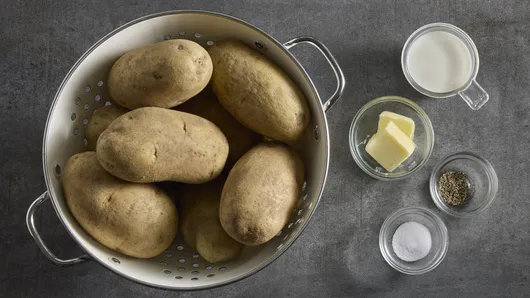
![]()
![]()
![]()
![]()
![]()
![]()
![]()









